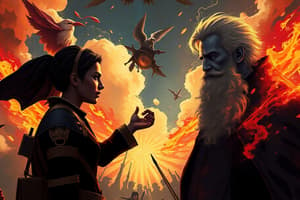Podcast
Questions and Answers
What are the two main class groups in Marx's conflict theory?
What are the two main class groups in Marx's conflict theory?
Bourgeoisie and Proletariat
What describes the relationship between the bourgeoisie and the proletariat?
What describes the relationship between the bourgeoisie and the proletariat?
Mutualistic but coercive
What does false consciousness refer to in Marx's theory?
What does false consciousness refer to in Marx's theory?
Believing in ideologies that support the ruling class despite being disadvantageous to working-class interests
Which institutions perpetuate ideology according to Marx?
Which institutions perpetuate ideology according to Marx?
What is class consciousness?
What is class consciousness?
What is the difference between a 'class in itself' and a 'class for itself'?
What is the difference between a 'class in itself' and a 'class for itself'?
Weber agreed entirely with Marx's view of social class.
Weber agreed entirely with Marx's view of social class.
What are the three primary bases of power according to Weber?
What are the three primary bases of power according to Weber?
How many classes did Weber define compared to Marx's two classes?
How many classes did Weber define compared to Marx's two classes?
Flashcards are hidden until you start studying
Study Notes
Marx's Conflict Theory
- Human behavior is a result of power struggles between two main classes: the bourgeoisie (capitalists, owners of production) and the proletariat (workers, who own only their labor).
- The relationship between these classes is mutualistic yet coercive; workers reliant on capitalists for income while capitalists depend on workers for labor.
- The capitalist class holds an advantage, maintaining low wages and poor working conditions due to the expendability of workers.
Importance of Ideology
- Ideologies support and perpetuate the class system, guiding individuals' lives both consciously and unconsciously.
- Dominant ideas reflect the interests of the ruling class and include beliefs like meritocracy and equality of opportunity.
- Institutions such as family, media, and education disseminate these ideologies, which become accepted as societal norms.
- False consciousness arises when the working class adopts ideologies that ultimately harm their interests, inhibiting unity against the ruling class.
Role of Unions
- Class struggles stem from opposing interests between capitalists aiming for profit and workers needing fair wages and conditions.
- Class consciousness is the awareness of one’s social class and its interests, distinguishing between "class in itself" (proletariat) and "class for itself" (actively organized workers).
- Unions represent "class for itself," advocating for better working conditions and pay through collective bargaining, countering dominant ideologies.
Comparison of Marx's and Weber's Theories
- Both theorists recognize economic power's significance in determining social class, but Weber highlights additional non-economic factors.
- Weber introduced "status groups," emphasizing three bases of power: economic class, social status (prestige), and political party (influence).
- Unlike Marx's binary class system, Weber identifies four classes:
- Large capitalists (employ significant labor without direct engagement),
- Small capitalists (petite bourgeoisie, directly engage with workers),
- Specialists (white-collar workers),
- Working class (manual labor).
Weber's Theory of Social Status
- Status groups contribute to understanding social stratification by incorporating factors beyond economic class, including cultural and social prestige.
- These groups highlight how social hierarchies affect individuals' opportunities and social mobility beyond mere economic standing.
Studying That Suits You
Use AI to generate personalized quizzes and flashcards to suit your learning preferences.




